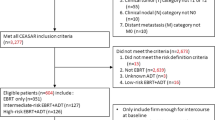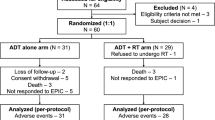Abstract
Radiation therapy for prostate cancer can cause erectile dysfunction (ED). Intensity Modulated Radiation Therapy (IMRT) can reduce the amount of radiation to surrounding tissues associated with ED. We characterize the incidence of and factors associated with ED in prostate cancer patients after IMRT at the National Naval Medical Center (NNMC). Patients potent by definition of the Sexual Health Inventory for Men (SHIM) before treatment completed the specific erectile questions of the SHIM after IMRT. Statistical analyses were performed to examine the relationships between several factors and ED. Thirty-two of 45 patients with mean age of 68.2 years (50–86 years) completed the SHIM. The median follow-up was 36.8 months (16–63.6 months) as defined by the time from completion of therapy to reassessment with the SHIM. Eight of 32 patients (25%) had no post-treatment ED (SHIM score 22–25), three of 32 (9%) had mild post-treatment ED (SHIM score 17–21), five of 32 (16%) had mild to moderate ED (SHIM score 12–16), five of 32 (16%) had moderate ED (SHIM score 8–11) and 11 of 32 (34%) had severe post-treatment ED (SHIM score<8). Post-treatment potency was significantly associated with the pre-treatment SHIM score (P=0.001) and history of hypertension (P=0.03). The mean radiation dose to the penile bulb and volume of penile bulb treated were not associated with post-treatment potency (P=0.38, 0.76, respectively). IMRT maintains potency in the majority of patients. This analysis compares favorably in preserving erectile function to previously reported series using conventional external beam radiation therapy techniques. The dose of radiation received by the penile bulb and volume of penile bulb were not associated with post-treatment ED in this analysis.
This is a preview of subscription content, access via your institution
Access options
Subscribe to this journal
Receive 4 print issues and online access
$259.00 per year
only $64.75 per issue
Buy this article
- Purchase on Springer Link
- Instant access to full article PDF
Prices may be subject to local taxes which are calculated during checkout
Similar content being viewed by others
References
Jemal A, Siegel R, Ward E, Murray T, Xu J, Smigal C et al. Cancer Statistics, 2006. CA Cancer J Clin 2006; 56: 106–130.
D'Amico AV, Whittington R, Malkowicz SB, Schultz D, Blank K, Broderick GA et al. Biochemical outcome after radical prostatectomy, external beam radiation therapy, or interstitial radiation therapy for clinically localized prostate cancer. JAMA 1998; 280: 969–974.
Davis JW, Kuban DA, Lynch DF, Schellhammer PF . Quality of life after treatment for localized prostate cancer: differences based on treatment modality. J Urol 2001; 166: 947–952.
Catalona WJ, Dresner SM . Nerve-sparing radical prostatectomy: extraprostatic tumor extension and preservation of erectile function. J Urol 1985; 134: 1149–1151.
Catalona WJ, Bigg SW . Nerve-sparing radical prostatectomy: evaluation of results after 250 patients. J Urol 1990; 143: 538–544.
Finkle AL . Sexual potency: a pioneer's thirty-five-year overview. Urology 1988; 32: 511–515.
Jonler M, Messing EM, Rhodes PR, Bruskewitz RC . Sequelae of radical prostatectomy. Br J Urol 1994; 74: 352–358.
Litwin MS, Flanders SC, Pasta DJ, Stoddard ML, Lubeck DP, Henning JM . Sexual function and bother after radical prostatectomy or radiation for prostate cancer: multivariate quality-of-life analysis from CaPSURE. Urology 1999; 42: 622–629.
Merrick GS, Wallner K, Butler WM, Galbreath RW, Lief JH, Benson ML . A comparison of radiation dose to the bulb of the penis in men with and without prostate brachytherapy-induced erectile dysfunction. Int J Radiat Oncol Biol Phys 2001; 50: 597–604.
Merrick GS, Butler WM, Wallner KE, Lief JH, Anderson RL, Smeiles BJ et al. The importance of radiation doses to the penile bulb vs. crura in the development of postbrachytherapy erectile dysfunction. Int J Radiat Oncol Biol Phys 2002; 54: 1055–1062.
Michalski JM, Purdy JA, Winter K, Roach III M, Vijayakumar S, Sandler HM et al. Preliminary report of toxicity following 3D radiation therapy for prostate cancer on 3DOG/RTOG 9406. Int J Radiat Oncol Biol Phys 2000; 46: 391–402.
Mulhall JP, Yonover P, Sethi A, Yasuda G, Mohideen N . Radiation exposure to the corporeal bodies during 3-dimensional conformal radiation therapy for prostate cancer. J Urol 2002; 167: 539–542.
Pickett BM, Weinberg V, Roach M . Dose to the bulb of the penis is associated with the risk of impotence following radiotherapy for prostate cancer. Urology 1999; 57: 955–959.
Roach M . Correlation of radiation dose and impotence risk after three-dimensional conformal radiotherapy for prostate cancer. Reply by the authors (Letter). Urology 2001; 58: 828.
Roach M, Winter K, Michalski JM, Cox JD, Purdy JA, Bosch W et al. Penile bulb dose and impotence after three-dimensional conformal radiotherapy for prostate cancer on RTOG 9406: findings from a prospective, multi-institutional, phase I/II dose-escalation study. Int J Radiat Oncol Biol Phys 2004; 60: 1351–1356.
Robinson JW, Moritz S, Fung T . Meta-analysis of rates of erectile function after treatment of localized prostate carcinoma. Int J Radiat Oncol Biol Phys 2002; 54: 1063–1068.
Selek U, Cheung R, Lii M, Allen P, Steadham RE, Vantreese Jr TR et al. Erectile dysfunction and radiation dose to penile base structures: a lack of correlation. Int J Radiat Oncol Biol Phys 2004; 59: 1039–1046.
Sethi A, Mohideen N, Leybovich L, Mulhall J . Role of IMRT in reducing penile doses in dose escalation for prostate cancer. Int J Radiat Oncol Biol Phys 2003; 55: 970–978.
Stanford JL, Feng Z, Hamilton AS, Gilliland FD, Stephenson RA, Eley JW et al. Urinary and sexual function after radical prostatectomy for clinically localized prostate cancer: The Prostate Cancer Outcomes Study. JAMA 2000; 283: 354–360.
Walsh PC, Donker PJ . Impotence following radical prostatectomy: insight into etiology and prevention. J Urol 1982; 128: 492–497.
Walsh PC . Radical prostatectomy, preservation of sexual function, cancer control: the controversy. Urol Clin N Am 1987; 14: 663–673.
Beard CJ, Propert KJ, Rieker PP, Clark JA, Kaplan I, Kantoff PW et al. Complications after treatment with external-beam irradiation in early-state prostate cancer patients: a prospective multiinstitutional outcomes study. J Clin Oncol 1997; 15: 223–229.
Beard CJ, Lamb C, Buswell L, Schneider L, Propert KJ, Gladstone D et al. Radiation-associated morbidity in patients undergoing small-field external beam irradiation for prostate cancer. Int J Radiat Oncol Biol Phys 1998; 41: 257–262.
Crook J, Esche B, Futter N . Effect of pelvic radiotherapy for prostate cancer on bowel, bladder, and sexual function: the patient's perspective. Urology 1996; 47: 387–394.
Mantz CA, Song P, Farhangi E, Nautiyal J, Awan A, Ignacio L et al. Potency probability following conformal megavoltage radiotherapy using conventional doses for localized prostate cancer. Int J Radiat Oncol Biol Phys 1997; 37: 551–557.
Mantz CA, Nautiyal J, Awan A, Kopnick M, Ray P, Kandel G et al. Potency preservation following conformal radiotherapy for localized prostate cancer: impact of neoadjuvant androgen blockate, treatment technique, and patient-related factors. Cancer J Sci Am 1999; 5: 230–236.
Zelefsky MJ, Cowen D, Fuks Z, Shike M, Burman C, Jackson A et al. Long term tolerance of high dose three-dimensional conformal radiotherapy in patients with localized prostate carcinoma. Cancer 1999; 85: 2460–2468.
Bhatnagar V, Stewart ST, Huynh V, Jorgensen G, Kaplan RM . Estimating the risk of long-term erectile, urinary and bowel symptoms resulting from prostate cancer treatment. Prostate Cancer Prostatic Dis 2006; 9: 136–146.
DiBiase SJ, Wallner K, Tralins K, Sutlief S . Brachytherapy radiation doses to the neurovascular bundles. Int J Radiat Oncol Biol Phys 2000; 46: 1301–1307.
Fisch BM, Pickett B, Weinberg V, Roach M . Dose of radiation received by the bulb of the penis correlates with risk of impotence after three-dimensional conformal radiotherapy for prostate cancer. Urology 2001; 57: 955–959.
Kiteley RA, Lee WR, DeGuzman AF, Mirzaei M, McCullough DL . Radiation dose to the neurovascular bundles or penile bulb does not predict erectile dysfunction after prostate brachytherapy. Brachytherapy 2002; 1: 90–94.
Wernicke AG, Valicenti R, Dieva K, Houser C, Pequignot E . Radiation dose delivered to the proximal penis as a predictor of the risk of erectile dysfunction after three-dimensional conformal radiotherapy for localized prostate cancer. Int J Radiat Oncol Biol Phys 2004; 60: 1357–1363.
Rosen RC, Cappelleri JC, Smith MD, Lipsky J, Pena BM . Development and evaluation of an abridged, 5-item version of the International Index of Erectile Function (IIEF-5) as a diagnostic tool for erectile dysfunction. Int J Impot Res 1999; 11: 319–326.
McCullagh P . Regression models for ordinal data (with discussion). J R Stat Soc Ser B 1980; 42: 109–142.
Beckendorf V, Hay M, Rozan R, Lagrange JL, N'Guyen T, Giraud B . Changes in sexual function after radiotherapy treatment of prostate cancer. Br J Urol 1996; 77: 118–123.
Fokdal LU, Hoyer M . Late effects following curative radiotherapy for prostate cancer. Ugeskr Laeger 2005; 167: 3502–3507.
Goldstein I, Feldman MI, Deckers PJ, Babayan RK, Krane RJ . Radiation-associated impotence. A clinical study of its mechanism. JAMA 1984; 251: 903–910.
Gragasin FS, Michelakis ED, Hogan A, Moudgil R, Hashimoto K, Wu X et al. The neurovascular mechanism of clitoral erection: nitric oxide and cGMP-stimulated activation of BKCa channels. FASEB J 2004; 18: 1382–1391.
Helgason AR, Fredrikson M, Adolfsson J, Steineck G . Decreased sexual capacity after external radiation therapy for prostate cancer impairs quality of life. Int J Radiat Oncol Biol Phys 1995; 32: 33–39.
Zelefsky MJ, Eid JF . Elucidating the etiology of erectile dysfunction after definitive therapy for prostatic cancer. Int J Radiat Oncol Biol Phys 1998; 40: 129–133.
Zinreich ES, Derogatis LR, Herpst J, Auvil G, Piantadosi S, Order SE . Pre and post treatment evaluation of sexual function in patients with adenocarcinoma of the prostate. Int J Radiat Oncol Biol Phys 1990; 19: 729–732.
Buyyounouski MK, Horwitz EM, Uzzo RG, Price RA, McNeeley SW, Azizi D et al. The radiation doses to erectile tissues defined with magnetic resonance imaging after intensity modulated radiation therapy or iodine-125 brachytherapy. Int J Radiat Oncol Biol Phys 2004; 59: 1383–1391.
Buyyounouski MK, Horwitz EM, Price RA, Hanlon AL, Uzzo RG, Pollack A . Intensity-modulated radiotherapy with MRI simulation to reduce doses received by erectile tissue during prostate cancer treatment. Int J Radiat Oncol Biol Phys 2004; 58: 743–749.
Kao J, Turian J, Meyers A, Hamilton RJ, Smith B, Vijayakumar S et al. Sparing of the penile bulb and proximal penile structures with intensity-modulated radiation therapy for prostate cancer. Br J Radiol 2004; 77: 129–136.
Macdonald AG, Keyes M, Kruk A, Duncan G, Moravan V, Morris WJ . Predictive factors for erectile dysfunction in men with prostate cancer after brachytherapy: is dose to the penile bulb important? Int J Radiat Oncol Biol Phys 2005; 9: 136–146.
Carrier S, Hricak H, Lee SS, Baba K, Morgan DM, Nunes L et al. Radiation-induced decrease in nitric oxide synthase – containing nerves in the rat penis. Radiology 1995; 195: 95–99.
Acknowledgements
The views expressed in this article are those of the authors and do not necessarily reflect the official policy or position of the Department of the Army, Navy, Department of Defense, nor the US Government.
Author information
Authors and Affiliations
Corresponding author
Rights and permissions
About this article
Cite this article
Brown, M., Brooks, J., Albert, P. et al. An analysis of erectile function after intensity modulated radiation therapy for localized prostate carcinoma. Prostate Cancer Prostatic Dis 10, 189–193 (2007). https://doi.org/10.1038/sj.pcan.4500938
Received:
Revised:
Accepted:
Published:
Issue Date:
DOI: https://doi.org/10.1038/sj.pcan.4500938
Keywords
This article is cited by
-
Resveratrol treatment may preserve the erectile function after radiotherapy by restoring antioxidant defence mechanisms, SIRT1 and NOS protein expressions
International Journal of Impotence Research (2018)
-
Baseline status and dose to the penile bulb predict impotence 1 year after radiotherapy for prostate cancer
Strahlentherapie und Onkologie (2016)
-
Longitudinal change in health-related quality of life after intensity-modulated radiation monotherapy for clinically localized prostate cancer
Quality of Life Research (2014)
-
Erectile dysfunction after radiotherapy for prostate cancer: a model assesing the conflicting literature on dose–volume effects
International Journal of Impotence Research (2013)
-
Stereotactic Body Radiation Therapy (SBRT) for clinically localized prostate cancer: the Georgetown University experience
Radiation Oncology (2013)



